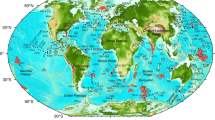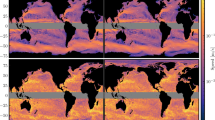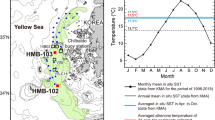Abstract
Attempts to explain quasiperiodic glacial/interglacial transitions1 in the Pleistocene 18O deep-sea stratigraphic record have focused on spectral analysis of palaeoclimatic data and comparisons with Milankovitch-type calculations of variations in isolation caused by periodicities of the Earth's orbit around the Sun2–6. Periods close to those of orbital eccentricity (100 kyr), obliquity (41 kyr), and precession (22 kyr) can be identified in deep-sea cores, but their relative strengths are very different from those of solar insolation and other peaks are also present. Mixing of sediment by deposit-feeding infauna significantly perturbs stratigraphic boundaries in deep-ocean sediments7. Although mixing models8–11 have been proposed to describe quantitative effects of bioturbation no formulation of the effect of this process on the spectrum of the climatic record has been presented. Using the signal processing model11, the suppression of recorded climatic variation over the past 700 kyr is estimated. In the frequency range where changes in the Earth's orbital path affect incident solar radiation the results support an appreciably larger role for astronomical ‘forcing’ of climate than previously estimated.
This is a preview of subscription content, access via your institution
Access options
Subscribe to this journal
Receive 51 print issues and online access
$199.00 per year
only $3.90 per issue
Buy this article
- Purchase on Springer Link
- Instant access to full article PDF
Prices may be subject to local taxes which are calculated during checkout
Similar content being viewed by others
References
Emiliani, C. J. Geol. 63, 538–578 (1955).
Kemp, W. C. & Eger, D. T. J. geophys. Res. 72, 739–751 (1967).
Hays, J. D., Imbrie, J. & Shackleton, N. J. Science 194, 1121–1132 (1976).
Rooth, C. G. H., Emiliani, C. & Poor, H. W. Earth planet. Sci. Lett. 41, 387–394 (1978).
Kominz, M. A. & Pisias, N. G. Science 204, 171–173 (1979).
Kominz, M. A., Heath, G. R., Ku, T.-L. & Pisias, N. G. Earth planet. Sci. Lett. 45, 394–410 (1979).
McIntyre, A., Bé, A. W. H. & Preikstas, R. Prog. Oceanogr. 4, 3–25 (1967).
Davis, R. B. Limnol. Oceanogr. 19, 466–488 (1974).
Berger, W. H. & Heath, G. R. J. mar. Res. 26, 134–143 (1968).
Guinasso, N. L. & Schink, D. R. J. geophys. Res. 80, 3032–3043 (1975).
Goreau, T. J. Nature 265, 525–526 (1977).
Emiliani, C., Rooth, C. G. H. & Stipp, J. J. Earth planet. Sci. Lett. 41, 159–162 (1978).
Berger, W. H. Nature 269, 301–304 (1977).
Berger, W. H. Deep Sea Res. 25, 473–479 (1978).
Jenkins, G. M. & Watts, D. G. Spectral Analysis and its Applications (Holden Day, San Francisco, 1968).
Emiliani, C. Earth planet. Sci. Lett. 37, 349–352 (1978).
Evans, D. L. & Freeland, H. J. Science 198, 528–529 (1978).
Ruddiman, W. F. & Glover, L. K. Bull. geol. Soc. Am. 83, 2817–2836 (1972).
Glass, B. P. Earth planet. Sci. Lett. 6, 409–415 (1972).
Erez, J. Nature 281, 535–538 (1979).
Erez, J. Nature 273, 199–202 (1977).
Goreau, T. J. Proc. R. Soc. B196, 291–315 (1977).
Suarez, M. J. & Held, I. M. J. geophys. Res. 84, 4825–4836 (1979).
Imbrie, J. & Imbrie, J. Z. Science 207, 943–953 (1980).
Hasselman, K. Tellus 28, 473–485 (1976).
Cathles, L. M. The Viscosity of the Earth's Mantle (Princeton University Press, 1975).
Birchfield, G. E. & Weertman, J. J. geophys. Res. 83, 4123–4125 (1978).
Emiliani, C. & Geiss, J. Geol. Rdsch. 46, 576–601 (1958).
Ruddiman, W. F. et al. Sedim. Geol. 25, 257–276 (1980).
Hutson, W. H. Geology 8, 127–130 (1980).
Peng, T.-H., Broecker, W. S. & Berger, W. H. Quat. Res. 11, 141–149 (1979).
Krishnaswami, S., Benninger, L. K., Aller, R. C. & Van Dam, K. L. Earth planet. Sci. Lett. 47, 307–318 (1980).
Fisher, J. B., Lick, W. J., McCall, P. L. & Robbins, J. A. J. geophys. Res. 85, 3997–4006 (1980).
Author information
Authors and Affiliations
Rights and permissions
About this article
Cite this article
Goreau, T. Frequency sensitivity of the deep-sea climatic record. Nature 287, 620–622 (1980). https://doi.org/10.1038/287620a0
Received:
Accepted:
Issue Date:
DOI: https://doi.org/10.1038/287620a0
This article is cited by
-
A strategy for frequency spectra of quaternary climate records
Climate Dynamics (1991)
-
Paleoclimatic variability at frequencies ranging from 1 cycle per 10 000 years to 1 cycle per 1000 years: Evidence for nonlinear behaviour of the climate system
Climatic Change (1988)
-
Effect of benthic mixing on the information content of deep-sea stratigraphical signals
Nature (1984)
-
Interaction of cryospheric forcings with rotational dynamics has consequences for ice ages
Nature (1982)
-
Orbital signature of interglacials
Nature (1981)
Comments
By submitting a comment you agree to abide by our Terms and Community Guidelines. If you find something abusive or that does not comply with our terms or guidelines please flag it as inappropriate.



